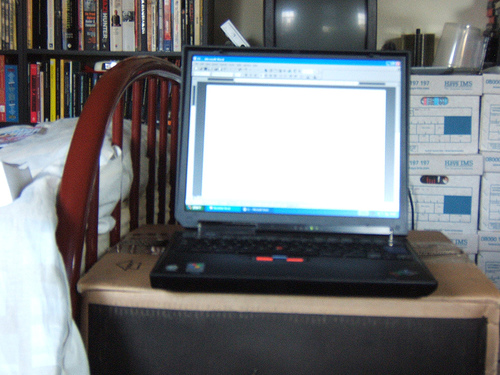
Not everyone has an elephant lurking in the downstairs closet, a brachiosaurus in the garage … but a lot of us do. And by this I of course don’t actually mean elephants or dinosaurs, but projects. Big projects. Big, ugly, scary projects that are disturbing to even think about because they’re so big and we haven’t even started on them (or have left them sitting around for much too long). It might be a major house repair that needs to be done so that the roof won’t start leaking, or a long overdue class assignment, or a book project that got tricky and has been sitting there on the hard drive, mocking you, for months now. Regardless of exactly what your beast is, there’s a simple, immediate way to take the first step toward vanquishing it. Unimpressively enough, it’s called “Do any little part of it … right now.”
Don’t take “right now” too literally: “right now” could be this weekend, or later today, or for two hours on Thursday. But don’t mess around with “right now” too much, either. As big as some projects are, there are very few that couldn’t benefit from a little attention very soon, even if it’s late at night and you’re tired and the project is unmentionably huge.
“Do any little part of it right now” may sound simple, and it is very easy to act on, but it has impact far beyond the effort required for it. Consider this joke:
Q: How do you eat an elephant?
A: One bite at a time.
It’s true. Humans are designed to eat things in bites, so the size of the what you’re eating doesn’t matter. To put it another way, you never, ever have to do a huge task: you only have to do small steps that over time add up to a huge task. That may sound like just playing with words, but it’s much more substantial than that: all large projects are accomplished through small steps, so the only way to do a large project is to do one small step. Then do another. Then another.
And honestly, the first small step breaks the whole thing wide open. Instead of having to say “I haven’t worked on my book in four months,” you can say “I worked on my book last night, even though it was only for 20 minutes.” Instead of saying “Someday I have to clean out that junk room,” you can say “I spent 45 minutes this morning gathering up all the spare linens I had in the junk room, and now the ones we need are in the linen closet and the rest are in the car, ready to go to the Salvation Army.” Zero small steps is a dead stop. One small step is being right in the midst of getting the job done.
Sometimes it may be hard to see what the small steps are, either because there’s so much to do that it’s all a huge tangle or because the big project consists of just doing one thing for a long, long time. In either case, there are ways to proceed. If you have no idea where to start, then the first step is figuring out what your next few steps are going to be. It’s organization, cataloging the problem. For instance, if your project is making a garden, make a list of things you need to do to be able to break ground: plan the size of the garden, choose what you’ll plant, look up the planting schedules, buy the seeds, etc. Making that list is itself the first step, and by the time you’re done, you’ll know what the second and third steps are already. If at any point you don’t know what to do next, that means that what you need to do next is figure out where you are in the project and what action needs to come next in the sequence.

And if the project is just a whole lot of one thing, then your steps are just pieces of that thing, of any size. Writers face this issue all the time, when the goal is to write a novel of, say, 100,000 words. While there might be (depending on the writer) a lot of preparatory work to do (or none at all), at a certain point the job is to sit down and churn out a lot of words. While you do that, you can count chapters, pages, words, hours at the keyboard, plot points completed, or anything else that gets you through the night, but if the project is daunting, figure out how much of some measure you need to do, then start doing that thing-and counting it.
Of course, after that first step there is always a second, and so on, and this discussion doesn’t delve much into the question of how to keep on track. On the other hand, keeping on track is much easier than getting on track in the first place, so if you have a big project you know you need to tackle, try starting in on any constructive piece of it, and if you don’t find yourself plowing ahead naturally, come back here for more ideas on how to keep the engine moving. After all, I’ve got a lot more I’ll need to post on this site over the course of years, and the only way for me to do it is one post at a time.
Elephant picture by Omar Junior.
Blank screen picture by Simon Scott.


